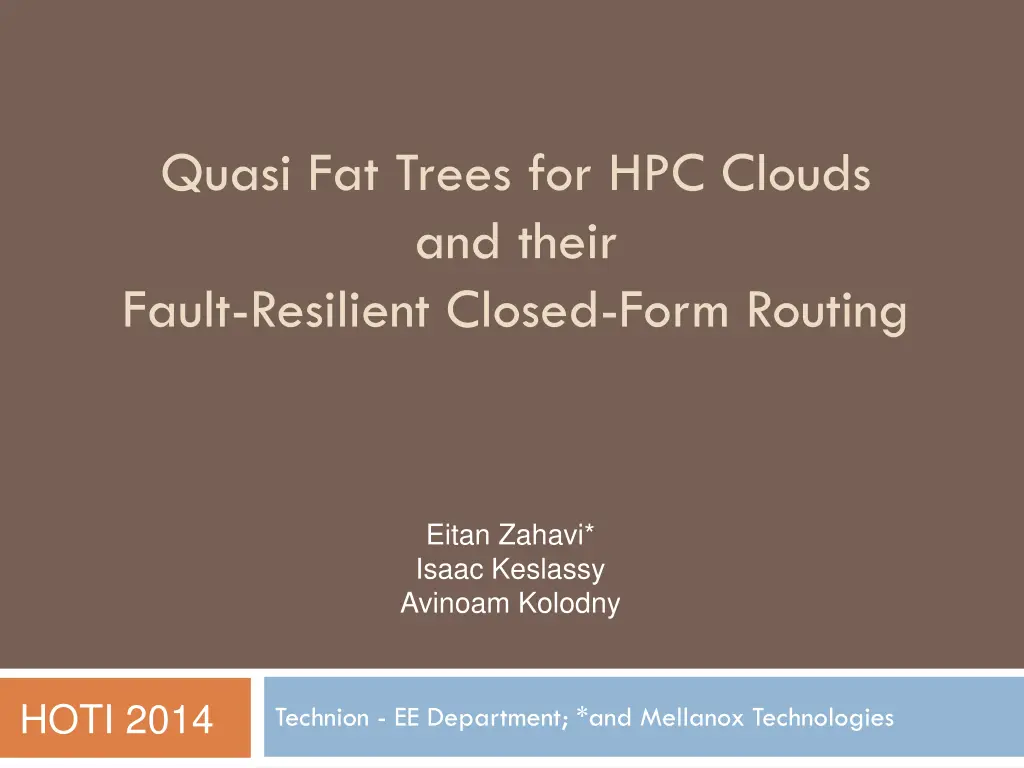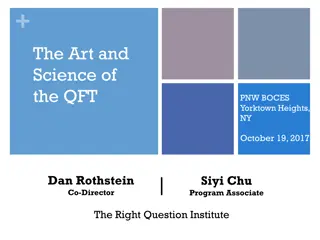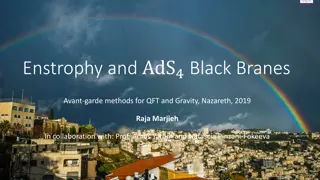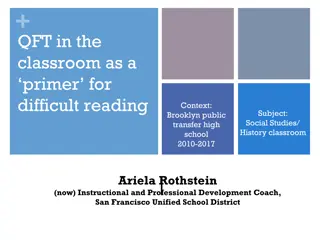
Exploring Quasi Fat Trees for HPC Clouds and Fault-Resilient Routing
Discover the utility and advantages of Quasi Fat Trees in HPC and cloud environments, including their fault-resilient closed-form routing capabilities. Learn about the evolution of Fat Trees, Multi-Root Fat Trees, Extended Generalized Fat Trees (XGFT), and more advanced network topologies. Explore the concept of bisectional bandwidth and how it applies to different levels of port switches. Dive into building non-maximal topologies with XGFT trees and understand the scalability and flexibility offered by these innovative network structures.
Download Presentation

Please find below an Image/Link to download the presentation.
The content on the website is provided AS IS for your information and personal use only. It may not be sold, licensed, or shared on other websites without obtaining consent from the author. If you encounter any issues during the download, it is possible that the publisher has removed the file from their server.
You are allowed to download the files provided on this website for personal or commercial use, subject to the condition that they are used lawfully. All files are the property of their respective owners.
The content on the website is provided AS IS for your information and personal use only. It may not be sold, licensed, or shared on other websites without obtaining consent from the author.
E N D
Presentation Transcript
Quasi Fat Trees for HPC Clouds and their Fault-Resilient Closed-Form Routing Eitan Zahavi* Isaac Keslassy Avinoam Kolodny HOTI 2014 Technion - EE Department; *and Mellanox Technologies
What is common to these Clusters? 2 They are all Utility Clusters Their network topologies is Quasi Fat Tree
Fat Trees 3 Commonly used in HPC Lately also in Data Centers Why? Flexible tradeoff of BW vs. cost Superior in number of minimum paths Very shallow, very wide
The Fat Tree Evolution 4 A Tree Trivial forwarding Link capacity grows towards the root This ensures no contention for ALL permutations 1 2 M 1 2 N 1 2 N 1 2 N [1] C. E. Leiserson, Fat-trees: universal networks for hardware-efficient supercomputing, IEEE Trans. Computing 1985.
Multi Root Fat Trees 5 E.g. k-ary n-tree Scaleable since all switches/links are identical Static Routing = some permutations are contending The constant k represents half the number of switch ports If same switch device is used for all levels, top switches utilize only half their ports n k k 2 k k 1 4-ary 3-tree [2] F. Petrini and M. Vanneschi, k-ary n-trees: high performance networks for massively parallel architectures, in Parallel Processing Symposium, 1997.
Extended Generalized Fat Tree - XGFT 6 Allows varying of k per level Graph structure is formally defined Maintains: A single link between switches; Being collection of trees Flexible Bisectional Bandwidth ????( ; ?1 ? ; ?1 ? ) h n m3 k w3 k 2 2 m2 k k w2 1 1 m1 w1 4-ary 3-tree ????(3;4,2,8;1,2,8) [3] S. R. Ohring, et al., On generalized fat trees, in IPPS 1995
The 3 level XGFT of 8 port switches 7 This is the single and maximal constant bisectional bandwidth XGFT of 3 levels 8 ports switches !
Building non-maximal topology 8 Given a switch device of 8 ports, build 64 nodes XGFT tree Remember only a single link is allowed between a pair of switches 2
Parallel Ports Generalized Fat Trees 9 Allow parallel ports (introduce port objects and numbering) XGFT has dangling 2 ports for each levels 1 or 2 switches PGFT allows parallel links so now all ports being used 2 2 XGFT PGFT
The Quasi Fat Tree 10 Provides better use for the extra links: Connect to side branches and reduce average diameter QFT is no longer a collection of trees On Fat Tree there is a single path* from parent switch to any of its children. On QFT there are several such paths Parent Parent QFT XGFT Child Child
QFT reduces the Effective Diameter 11 Smaller jobs see higher impact on their effective diameter If jobs fits into a sub-tree it gets lower latency and higher BW QFT provides the maximal number of hosts in a sub-tree It is independent of cluster size PGFTs sub-tree size is reduced with the cluster size 2 2 QFT PGFT sub tree sub tree
12 Jobs on PGFT/QFT 12 An experiment to show the impact of the larger QFT sub-trees A 4536 nodes 3 level PGFT and QFT Fat Trees 12 jobs of job size Normal(300,20) Realistic placement of continuous fragments of TruncNormal(36,10) Traffic is random Shift Permutations MPI is sensitive to Max Latency / Min BW
From Many Small Jobs to Single Large Job 13 So far, we showed why QFT provides better performance then other Fat Trees for many concurrent small jobs Can QFT compete with other Fat Trees for single largest MPI job performance?
MPI Collectives mostly use Shifts 14 Collectives are used by most applications for best performance Shift permutations are the traffic pattern of ALL the Collectives In most MPI implementations for medium and large messages In every distance d the permutation is: Dst = (Src + d) % N 0 1 2 3 4 5 6 d = 1 d = 2 d = 3 d = 4 [4] E. Zahavi, Fat-Trees Routing and Node Ordering Providing Contention Free Traffic for MPI Global Collectives, IPDPS CASS, 2011
Routing for QFT 15 I.e. how to forward packets in the network (not L3) It is non-contending for All Shift Pattern i.e. ALL MPI Collectives FULL network jobs Closed Form Routing is a formula: ???? = ? ??????????? Significant runtime reduction compared to traversal based algorithms like DFSSSP, updn or the ftree engine
Routing is a Formula 16 ???? ?? 2 ? Define: ? ?= ?=1 From switch S to host Q (with index d) ??+1 ?? ??+1 ?? Descendant Criteria: ? ? + 2.. ??= ?? = ? ? ? 2 ??? ?? 1?? 1 ?? 1 The sub-group used 2 levels below: ? = ? Up-Port: ? = ? ??? 1+ ? ??? ??+1??+1 ?? 1 = ?? Down-Port:? = ??+ ???? 1??? ?? ??+ ????+1??? ?? 1 < ?? ? = 1 < ?? ? <
Fault Resiliency 17 For XGFT there is a single path down from a switch to host So losing a link between level ? and ? + 1 means all switches at level ? must avoid using matching link XGFT Fault Resiliency: Collect all missing links Calculate closed form routing If source or destination switches miss that link randomly choose available (on both switches) link QFT have many down paths They are formally recognized Only if all are lost use the Fat Tree algorithm above [5] Zhu Ding,et al, Level-wise Scheduling Algorithm for Fat Tree Interconnection Networks, SC 2006
Evaluation 18 Correctness Proven as non contending [6] New algorithm coded as part of OpenSM pqft engine Verified to provide non-contention routing for all shift permutations Runtime improvements (of single thread implementation) New pqft [6] http://technion.ac.il/~ezahavi/papers/qft_tr03_2014.pdf
Single Job BW Saturation 19 A single MPI job random Shift permutations Results show much higher saturation throughput for new pqft algorithm throughput reaches the link BW no contention Old updn Random Shift permutations
Conclusions 20 We defined and formulate QFT Non-Contention routing for global shifts This routing is closed form and resilient QFT outperforms other known Fat Tree flavors in both single job and multiple jobs scenarios
Thank you Questions?







